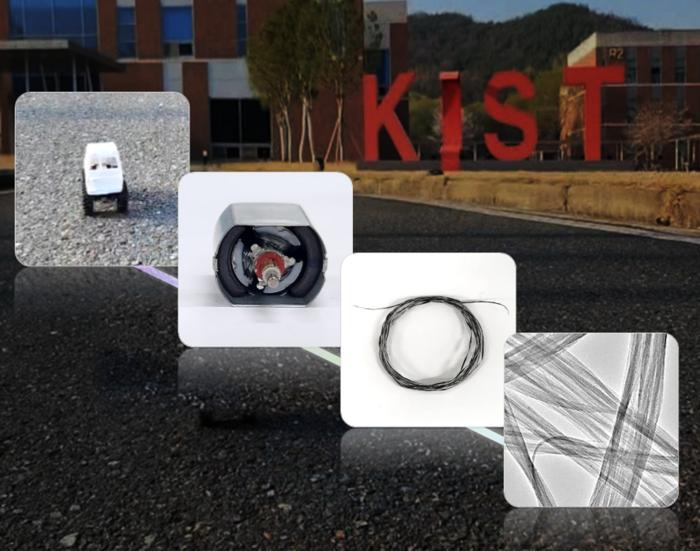According to a study published in Advanced Composites and Hybrid Materials, Dr. Dae-Yoon Kim and his team at the Korea Institute of Science and Technology (KIST) Composite Materials Research Institute were successful in building an electric motor coil out of only carbon nanotubes (CNTs) and making it run.
 KIST has developed a technology for producing high-quality CNTs by utilizing the liquid crystal state, often referred to as the “fourth state of matter”, distinct from solids, liquids and gases. This technology dramatically improves the electrical conductivity of CNT coils, allowing them to drive electric motors without the need for copper coils. Image Credit: Korea Institute of Science and Technology (KIST)
KIST has developed a technology for producing high-quality CNTs by utilizing the liquid crystal state, often referred to as the “fourth state of matter”, distinct from solids, liquids and gases. This technology dramatically improves the electrical conductivity of CNT coils, allowing them to drive electric motors without the need for copper coils. Image Credit: Korea Institute of Science and Technology (KIST)
Lightweighting is a prevalent technical difficulty for future transportation, whether in the form of electric vehicles, drones, or spacecraft. Reducing a vehicle's weight saves energy and improves battery efficiency and range. This is regarded as an important technology directly related to sustainability, since it enhances overall system performance and contributes to carbon emission reduction.
Electric motors, in particular, are a crucial component of most electric mobility vehicles, with coils accounting for a significant amount of the motor’s overall weight. Until recently, metals such as copper have been utilized as the primary material for coils due to their high electrical conductivity, but it has been repeatedly noted that they have several constraints, including difficulties in obtaining resources, price volatility, and weight issues due to high density.
The scientists experimented with connecting a CNT coil to the motor and discovered that the motor's revolutions per minute (RPM) could be reliably regulated based on input voltage. This proves that a motor’s essential operation, which turns electrical energy into mechanical rotating force, can be carried out without needing metal.
CNTs are one-dimensional tube-shaped nanomaterials containing carbon atoms organized in a hexagonal honeycomb configuration. They are significantly lighter than ordinary metals and have outstanding electrical, mechanical, and thermal conductivity. These features have long piqued interest as a next-generation material, but CNTs have encountered several challenges in real-world industrial applications.
One technical challenge is the accumulation of catalyst metals employed in the production process. These stay as metallic particles on the surface of CNTs, reducing their electrical characteristics, which are directly connected to motor performance. Thus, it is impossible to use CNTs in high-performance components.
The team has created a novel CNT purification technique using the alignment principle of liquid crystals, a “fourth state of matter” midway between liquid and solid. The technique spontaneously resolves significant aggregation during CNT alignment, efficiently eliminating metallic particles from the surface.
Most significantly, it can selectively remove pollutants without harming the CNTs' nanostructure, distinguishing it from other liquid- and gas-phase purification technologies. The conductivity of the cleaned CNTs improves significantly, allowing them to be used in genuine electric motors.
By developing a new concept of CNT high-quality technology that has never existed before, we were able to maximize the electrical performance of CNT coils to drive electric motors without metal. Based on the innovation of CNT materials, we will take the lead in localizing materials such as conductive materials for batteries, pellicles for semiconductors, and cables for robots.
Dr. Dae-Yoon Kim, Korea Institute of Science and Technology
The Ministry of Science and ICT (Minister Yoo Sang-im) under the Global Young Connect Project (RS-2024-00448639) and Nano Connect Project (RS-2024-00450610) of the National Research Foundation of Korea supported the study.
Journal Reference:
Ryu, K.-H., et al. (2025) Core-sheath composite electric cables with highly conductive self-assembled carbon nanotube wires and flexible macroscale insulating polymers for lightweight, metal-free motors. Advanced Composites and Hybrid Materials. doi.org/10.1007/s42114-025-01302-4.